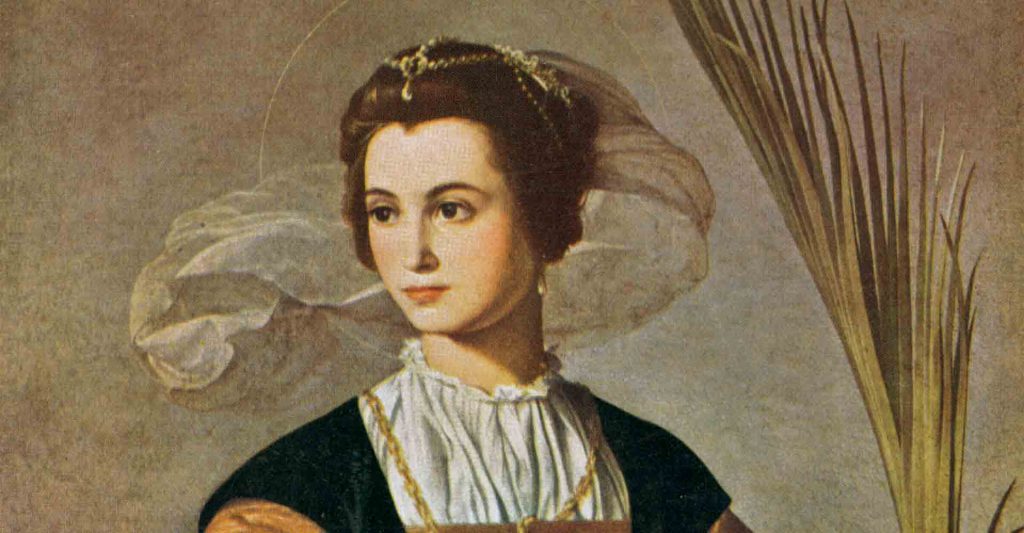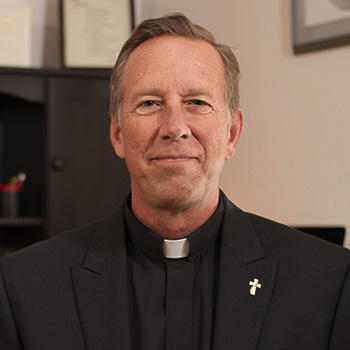
Saint Agnes of Rome, a young virgin martyred in Rome at the tender age of twelve or thirteen, is a unique and unrepeatable saint whose principled conviction, fidelity and dedication to Christ leaves men of the world, then as now, fascinated yet perplexed.
By Deacon Frederick Bartels
21 January 2019
In every age, Christ raises up saints whose lives and deaths display a love burning with the kiss of divine love. In and through and with Christ, inflamed with unforgettable and unique zeal for their Beloved, these saints defy logic and easily crush the ways of the world underfoot by virtue of their willingness to give life and limb for the sake of fidelity to their Savior.
St. Agnes, a young virgin martyred in Rome at the tender age of twelve or thirteen, is precisely one of these unique and unrepeatable persons whose fidelity and dedication to Christ leaves men of the world fascinated yet perplexed. Why would such a beautiful young woman with so many years ahead, seemingly toss away her life so carelessly? What could possibly move her to desire death and go smiling before her executioner? She had no need to insist she was Christian, to say those terrible words which sealed her conviction by identifying herself with a hated and misunderstood group of people who engaged in strange religious practices and worshipped a man who died a criminal’s death.

“Why not go on living?” they surely asked, then as they do now. But that is precisely the question—one of life. One of living. One of fidelity. One of everlasting happiness and bliss. Saint Agnes of Rome understood this question to a far greater degree than any number of witnesses who saw her positioned above the pyre, who watched the flames engulf her virgin body.
There’s a lot of mystery surrounding Saint Agnes’ life and death; this young virgin held in the highest honor by the Fathers of the Church since the 4th century. What we do know is that she was martyred in Rome sometime prior to the Emperor Constantine’s reign. The Catholic Encyclopedia suggests this may have occurred during the persecution of Christians imposed by Diocletian in about the year 304. But there is also evidence that she died at the hands of her persecutors earlier in the third century.
Read about Saints Perpetua and Felicity.
There are also varying accounts of her martyrdom. St. Ambrose gives her age as twelve and tells us she died by sword. The metrical panegyric of Pope Damasus recounts that she died by fire, without giving a thought to the barbaric execution she would endure, concerned only with covering her chaste, virgin body—stripped of its clothing and “exposed to the gaze of the heathen multitude”—with her hair. Prudentius tells us that the judge condemned her virginity by handing her over to a brothel, where a lustful man who looked upon her was stricken blind. And we find in The Acts of the Martyrdom of St. Agnes additional information stating that the virgin was “decapitated after remaining untouched by the flames” of the pyre (Ibid).
Saint Agnes of Rome stands as a monument of holiness and hope before us all. That will never change until that day when we, too, attain the fulfillment of our hope founded on the promises of Christ. On that day, we will admire the hope she had and enjoy the hope she acquired by virtue of her purity reserved for the Beloved and her love for the same.
From the Divine Office: From A Treatise On Virgins, By St. Ambrose:
Today is the birthday of a virgin; let us imitate her purity. It is the birthday of a martyr; let us offer ourselves in sacrifice. It is the birthday of Saint Agnes, who is said to have suffered martyrdom at the age of twelve. The cruelty that did not spare her youth shows all the more clearly the power of faith in finding one so young to bear it witness.
There was little or no room in that small body for a wound. Though she could scarcely receive the blow, she could rise superior to it. Girls of her age cannot bear even their parents’ frowns and, pricked by a needle, weep as for a serious wound. Yet she shows no fear of the blood-stained hands of her executioners. She stands undaunted by heavy, clanking chains. She offers her whole body to be put to the sword by fierce soldiers. She is too young to know of death, yet is ready to face it. Dragged against her will to the altars, she stretches out her hands to the Lord in the midst of the flames, making the triumphant sign of Christ the victor on the altars of sacrilege. She puts her neck and hands in iron chains, but no chain can hold fast her tiny limbs.
A new kind of martyrdom! Too young to be punished, yet old enough for a martyr’s crown; unfitted for the contest, yet effortless in victory, she shows herself a master in valor despite the handicap of youth. As a bride she would not be hastening to join her husband with the same joy she shows as a virgin on her way to punishment, crowned not with flowers but with holiness of life, adorned not with braided hair but with Christ himself.
In the midst of tears, she sheds no tears herself. The crowds marvel at her recklessness in throwing away her life untasted, as if she had already lived life to the full. All are amazed that one not yet of legal age can give her testimony to God. So she succeeds in convincing others of her testimony about God, though her testimony in human affairs could not yet be accepted. What is beyond the power of nature, they argue, must come from its creator.
What menaces there were from the executioner, to frighten her; what promises made, to win her over; what influential people desired her in marriage! She answered: “To hope that any other will please me does wrong to my Spouse. I will be his who first chose me for himself. Executioner, why do you delay? If eyes that I do not want can desire this body, then let it perish.” She stood still, she prayed, she offered her neck.
You could see fear in the eyes of the executioner, as if he were the one condemned; his right hand trembled, his face grew pale as he saw the girl’s peril, while she had no fear for herself. One victim, but a twin martyrdom, to modesty and to religion; Agnes preserved her virginity, and gained a martyr’s crown.
*****
Sharing is Caring!

Deacon Frederick Bartels is a member of the Catholic clergy who serves the Church in the diocese of Pueblo. He holds an MA in Theology and Educational Ministry, and is a Catholic educator, public speaker, and evangelist who strives to infuse culture with the saving principles of the gospel. For more, visit YouTube, iTunes and Twitter.
Leave a Reply